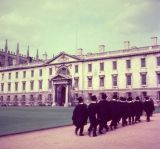On 9 June 1865, Charles Dickens was involved in a railway accident on a viaduct at Staplehurst, Kent, while returning from France with his mistress Ellen Ternan. Ten people died and forty were injured. Dickens himself died five years to the day after the crash.
I stopped mid-sentence – a broken train of thought.
On my lap was an episode of Our Mutual Friend.
That day, we’d swept through Kent like ink across a page,
the carriages jostling like words looking for meaning.
My eyes rested on hers, while starlings stitched the sky.
Through a field, across a meadow – and then: the viaduct.
It was a jolt like waking from sleep; a plunge from day
into night. Carriages splintered like books twisted apart
at the spine. Loose pages flew from the story and this time,
the story was mine. There was a cry like a birth or a death,
and I saw myself as a character, scratched into life
by my own pen. Along that dry riverbed we bumped
like the basket of a hot air balloon, until – silence.
Leaving Ellen with her mother, I climbed through a window,
at last the hero of my own life. I took a key from a guard
and emptied a carriage; found planks to make a ramp.
Some passengers were already ghosts. Others stared
through me, as if I were one myself. I doused the head
of a dying man with water from my top hat and fed him
a little brandy from my flask. The mud was thick with oil
and blood, the air – sulphurous – as if we had steamed
into Hades. I saw a woman lying against a pollard tree;
a trackman still holding his red flag. I did not speak for days.
I did not die then, but this was when I found the door
that led from life into death, and chose not to open it.



